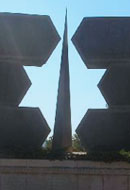Too Many Museums?

Although the paint is still wet on Philadelphia's National Museum of American Jewish History, an announcement has just been made of a planned National Museum of the Jewish People on Pennsylvania Avenue in Washington, D.C., steps from the United States Holocaust Memorial Museum and not far from both the Lillian and Albert Small Jewish Museum and the National Museum of American Jewish Military History. D.C. is not an anomaly: most U.S. states have at least one Jewish museum; many cities have several.
Nor is this an only-in-America phenomenon. Europe too is rapidly filling with Jewish museums—some built around the preserved death and concentration camps, but also places like the Jewish Museum at Oświęcim (Auschwitz), where an old synagogue has been preserved as a museum of the Jewish community that once lived in the town.
Jewish museums are quickly proliferating, in four varieties: museums that preserve Jewish buildings, Holocaust museums, art museums, and museums of Jewish history. But as each museum requires huge sums to build and maintain, we should ask ourselves if the investment is truly worthwhile.
An example of the museum as site of historic preservation is the Little Synagogue on the Prairie, a small, wooden shul built by the Jewish farmers of Sibbald, Alberta. Someone loved the abandoned shul enough to restore it for tourists. Baltimore's 1845 Lloyd Street synagogue is one of America's oldest surviving synagogue buildings; just down the street is the 1873 B'nai Israel synagogue. The first time I visited was on a tour; as we entered the sanctuary a small girl gasped, "it's . . . it's just like Princess Jasmine." She was right: the Moorish-revival style Ark is exactly what Walt Disney would have dreamed up for Aladdin's princess's bat mitzvah. Both are now preserved as part of the well-curated Jewish Museum of Maryland, which has its home in a modern building between the two shuls. It is a short walk from the popular Inner Harbor, and it is a good place to go if you want to be alone—as are the Jewish Museum of Florida, the Jewish Museum of Atlanta, the Jewish Museum London and, in my experience, most of the world's Jewish museums.
Holocaust museums draw the biggest crowds and the greatest attention. The U.S. Holocaust Memorial Museum and Jerusalem's Yad Vashem are the best known, though for me the most moving is the oldest: a small room on Mt. Zion in Jerusalem where walls are covered with simple memorial plaques put up by survivors just after the Shoah. The generosity of foundations, government agencies, and individual Jews and non-Jews to educate about the Shoah and honor the memory of the massacred is of course admirable. But despite the proliferation of Holocaust institutions, and the millions of dollars poured into each new entry in the field (most recently in Los Angeles), their impact has been qualified. Many such museums, trying to address all human evil under the rubric of the Holocaust, strip the event of all necessary distinctions, turning the attempted genocide of the Jews into a generalized lesson about prejudice.
Art museums, on the surface, are more straightforward. The Contemporary Jewish Museum in San Francisco, the Kansas City Jewish Museum of Contemporary Art, and New York's Jewish Museum are all dedicated to Jewish art. But what makes art Jewish? None of these museums seems particularly interested in answering that question. At New York's Jewish Museum, the answer has mostly been simply to exhibit the work of Jewish artists, such as Ezra Jack Keats or Hans and Margret Rey, the refugee couple who created Curious George. But whatever the merits of these artists' work, nothing about it contains Jewish content or concerns itself with matters of Jewish interest. Invited by the San Francisco's Contemporary to create seder plates for an exhibit entitled "New Works/Old Story: 80 Artists at the Passover Table," many artists seemed clueless about the contents of the book of Exodus or the proceedings of a seder. One artist's work was simply a scattering of shredded pages from the Haggadah. But, to adapt the language of that text, even if every artist were learned in the Torah, it would be no guarantee of aesthetic importance.
No museum is the result of spontaneous generation. Enormous Jewish resources have gone into creating these institutions, and much more is required for their upkeep. And even so, the empty, echoing corridors of so many Jewish museums suggest that the audience for such exhibits is likely to be limited.
So now is the time to ask ourselves: should every beloved old synagogue be preserved as a museum? How many Jewish history, art, and culture museums does the world need? Before we build the Alaska Jewish Historical Museum or the Russian-Jewish Museum of Tolerance, I suggest that we cast a very cold eye on the building of such institutions and ask whether it is the most efficacious use of our resources to honor the Jewish past and build the Jewish future.
Diana Muir Appelbaum is an American author and historian. She is at work on a book tentatively entitled Nationhood: The Foundation of Democracy.
Comments are closed for this article.




